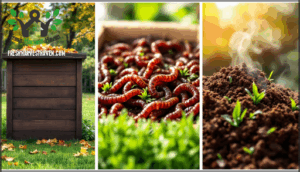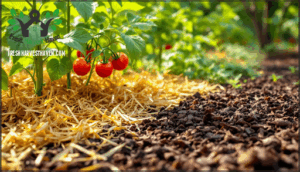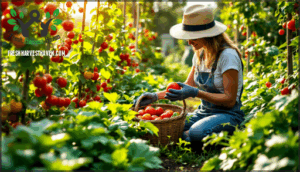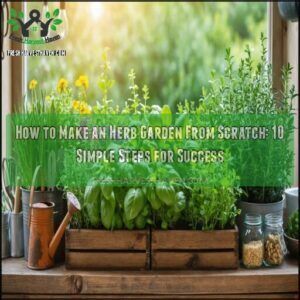This site is supported by our readers. We may earn a commission, at no cost to you, if you purchase through links.

Instead of watching your wallet drain at the checkout line while wondering what chemicals coat your produce, you can step into your backyard or balcony and harvest meals you control from seed to table.
This shift doesn’t require a farm or agricultural degree—just some outdoor space, basic tools, and knowledge of proven techniques. Your garden becomes both a practical solution to food security and an investment that pays dividends in health, savings, and environmental stewardship season after season.
Table Of Contents
- Key Takeaways
- Why Grow Your Own Sustainable Food?
- Planning Your Sustainable Food Garden
- Preparing Soil and Compost for Success
- Sustainable Gardening Techniques
- Maintaining and Expanding Your Food Supply
- Frequently Asked Questions (FAQs)
- Is growing your own food sustainable?
- How to grow sustainable food at home?
- What is the most sustainable food to grow?
- How to create a sustainable food system?
- How can I attract pollinators to my garden?
- What tools are essential for beginner gardeners?
- How do I store harvested produce properly?
- Which plants can be grown indoors year-round?
- How can I save seeds for future planting?
- How do I harvest vegetables at peak ripeness?
- Conclusion
Key Takeaways
- Growing your own food delivers measurable returns through $600-$2,830 in annual grocery savings, enhanced nutritional value (homegrown tomatoes contain 50% more lycopene), and dramatic pesticide exposure reduction of three to ten times compared to store-bought produce.
- Sustainable gardening actively fights climate change by eliminating transportation emissions, sequestering carbon in healthy soil, conserving water through efficient irrigation methods, and transforming kitchen waste into nutrient-rich compost instead of landfill contributions.
- Success starts with matching crops to your specific climate zone and available sunlight (most vegetables need six to eight hours daily), testing soil before adding amendments, and setting realistic goals by starting small with one or two crops you actually eat.
- Integrated Pest Management cuts pesticide use by 30-50% while maintaining yields through biological controls and beneficial insects, while techniques like crop rotation, companion planting, and seed saving build long-term garden resilience and true food independence.
Why Grow Your Own Sustainable Food?
Growing your own food isn’t just about planting seeds and waiting for harvest. It’s a decision that ripples outward, touching your health, your wallet, your local environment, and even your sense of purpose.
Growing your own food is a decision that ripples outward, touching your health, your wallet, your environment, and your sense of purpose
Let’s look at four compelling reasons why sustainable food gardening might be the right move for you.
Health and Nutritional Benefits
When you grow your own organic food, you’re taking control of nutrient density and healthy eating. Homegrown tomatoes pack up to 50% more lycopene, while fresh spinach retains 90% of its folate—store-bought versions lose nearly half after a week.
You’ll slash dietary exposure to pesticides, cutting residues by three to ten times compared to conventional fresh produce.
Gardening also delivers physical activity that strengthens immunity and boosts mental wellbeing, reducing stress and depression while improving food security for your household. For those with movement challenges, gardening in raised beds can be a beneficial modification.
Economic Savings and Food Security
Beyond nutrition, your garden delivers real grocery savings: a typical household cuts food costs by $2,830 annually, and even a modest 400-square-foot plot generates $600 worth of produce. One tomato plant costing $6 yields fruit worth $16.50.
During economic shocks, home food production strengthens food security—households with gardens face lower rates of food insecurity and reduced reliance on charitable sources, building crisis resilience and self-sufficiency through local food production.
Home gardens can yield substantial savings, with some estimating savings over $2,000.
Environmental Impact and Conservation
Your garden’s real power lies beneath the surface—it’s a living system that fights climate change, conserves resources, and restores nature. When you grow food sustainably, you’re cutting your carbon footprint while building resilient soil ecosystems that thrive for years.
Here’s what your garden does for the planet:
- Reduces greenhouse gas emissions by eliminating transportation from farm to table
- Conserves water through drip irrigation and mulching techniques
- Sequesters carbon in healthy soil, pulling CO2 from the atmosphere
- Fosters biodiversity by creating habitat for pollinators and beneficial insects
- Cuts waste by composting kitchen scraps instead of sending them to landfills
Sustainable gardening transforms environmental impact into environmental restoration—one plant at a time.
Community and Personal Well-being
What feeds the planet also feeds the soul—sustainable gardening doesn’t just grow vegetables, it grows connections, resilience, and a sense of purpose that extends far beyond your backyard.
Community gardens transform urban spaces into gathering places where neighbors share skills, seeds, and stories.
Growing your own food builds self-sufficiency while improving mental health through outdoor activity and meaningful work. You’re not just cultivating healthy eating and nutrition—you’re weaving social connections that strengthen food access for everyone.
Planning Your Sustainable Food Garden
Planning a sustainable food garden starts with understanding what you’re working with and what you want to achieve. Before you plant a single seed, you’ll need to evaluate your space, match crops to your growing conditions, design a layout that works, and set goals you can actually reach.
Here’s how to build a strong foundation for your garden.
Assessing Space and Sunlight
You don’t need a sprawling backyard to grow food—just the right spot with enough sunlight to fuel your plants. Here’s how to assess your space:
- Map sunlight patterns across your yard or patio throughout the day—most vegetables need six to eight hours of direct sun.
- Identify microclimates where walls, fences, or trees create warmer or shadier zones for different crops.
- Amplify vertical gardening and container suitability to get the most out of small spaces, turning balconies and patios into productive growing areas.
Choosing Crops for Your Climate
Choosing crops that thrive in your local conditions isn’t luck—it’s about matching plants to climate zones, and microclimates matter more than most realize. Start by identifying your hardiness zone, then seek out local varieties bred for your region’s temperature swings and rainfall patterns.
Crop hardiness guides and seasonal growing calendars help you time plantings perfectly, turning garden planning into a strategic advantage for sustainable gardening success while supporting climate change mitigation through smart gardening tips and techniques.
Creating a Garden Layout
A well-planned layout turns scattered beds into a food-producing ecosystem where every square foot pulls its weight. Map sunlight patterns across your garden space before placing beds—tall crops go north to avoid shading low growers.
Design paths wide enough for wheelbarrows, use companion planting to get the most from space optimization, and arrange beds for easy access. Smart garden design means productivity meets garden aesthetics naturally.
Setting Realistic Goals
Most first-time growers aim to feed their family for a year by August—then quit by September when reality hits. Start small with one crop you actually eat—maybe tomatoes or lettuce—and build from there.
Assess your time commitment honestly: even modest food gardens need consistent care. Track what works, manage expectations around increasing food production, and remember that growing your own food for better food security is a marathon, not a sprint.
Preparing Soil and Compost for Success
Think of your soil as the foundation of everything you’re about to grow—without healthy, well-fed earth, your plants won’t reach their full potential. Before you plant a single seed, you’ll need to understand how to enrich your soil, create your own compost, and protect what you’ve built.
Let’s walk through the three key steps that’ll set your garden up for long-term success.
Organic Soil Amendments
Think of your soil as a living bank account—without regular deposits, you’ll quickly run out of the nutrients your plants need to thrive. Start with soil testing to understand what you’re working with, then add organic matter like aged compost, green manure crops, or mineral powders to restore balance.
Biochar benefits include improved water retention, while mycorrhizal fungi boost nutrient uptake. Compost tea delivers a liquid dose of soil health directly to plant roots, supporting healthy organic gardening.
Home Composting Methods
Composting turns your kitchen scraps and yard waste into "black gold" for your garden—and you don’t need fancy equipment or a green thumb to get started. Choose a method that fits your space and lifestyle:
- Traditional compost bins work well in yards, processing kitchen scraps and yard waste in 3-6 months with regular turning
- Worm composting thrives indoors or out, transforming food scraps into nutrient-rich castings using red wiggler worms
- Compost activators speed decomposition when your pile seems stalled—or just add nitrogen-rich materials like grass clippings
Mulching and Soil Conservation
Once your compost is ready to work its magic, mulch becomes your garden’s protective shield—locking in moisture, blocking weeds, and keeping your soil healthy without constant tending.
Here’s how different mulch types support soil conservation and environmental sustainability:
| Mulch Types | Water Retention | Best For |
|---|---|---|
| Straw/Hay | Excellent – reduces evaporation by 50-70% | Vegetable gardens, no-till farming |
| Wood Chips | Good – breaks down slowly | Pathways, perennial beds |
| Shredded Leaves | Moderate – feeds soil organisms quickly | Annual gardens, erosion control |
| Grass Clippings | Good – adds nitrogen as it decomposes | Around established plants (thin layers) |
Apply 2-4 inches of organic mulch around your plants, keeping it away from stems to prevent rot. This simple sustainable gardening technique protects soil organisms, prevents erosion, and greatly reduces your watering needs—giving you more time to enjoy your garden instead of maintaining it.
Sustainable Gardening Techniques
Growing food sustainably isn’t just about what you plant—it’s about how you care for your garden throughout the season. The techniques you choose can make the difference between a garden that thrives with minimal waste and one that drains resources.
Let’s look at four core practices that’ll help you garden smarter, not harder.
Water Conservation and Irrigation
Smart watering isn’t just about turning on a hose—it’s about knowing when your plants actually need a drink and delivering it in ways that don’t waste a single drop. Check soil moisture before you irrigate, and you’ll avoid overwatering.
Here are some water-wise gardening methods that make a real difference:
- Drip irrigation delivers water directly to plant roots, reducing evaporation and runoff
- Rainwater harvesting captures free water from your roof for sustainable food gardening
- Mulching keeps soil moist longer while preventing weeds
- Drought-resistant crops thrive with less water, perfect for efficient irrigation systems
Crop Rotation and Companion Planting
Rotating where you plant each crop and pairing certain plants together can naturally protect your garden from pests and diseases while improving soil fertility season after season. Crop rotation prevents nutrient depletion and breaks pest cycles, while companion planting pairs crops that support each other—like tomatoes with basil for pest control or beans with corn for soil health. These sustainable gardening techniques deliver real yield increases without chemicals.
Integrated Pest Management
Integrated Pest Management (IPM) combines biological controls, habitat management, and minimal chemical use to keep pests in check without harming your soil or beneficial insects. This approach can cut pesticide use by 30–50% while maintaining or even boosting yields.
Here’s how you can implement IPM strategies in your garden:
- Monitor pest populations regularly and only intervene when they reach damaging levels
- Encourage beneficial insects like ladybugs and lacewings that naturally control pests
- Use physical barriers, traps, and hand-picking before reaching for any sprays
- Apply targeted biopesticides or organic solutions only when necessary
- Rotate pest control methods to prevent resistance from developing
Beyond environmental outcomes like healthier soil and water, IPM delivers real economic benefits—farmers worldwide have saved billions by adopting these sustainable gardening techniques, and you’ll see similar savings in your own backyard.
Reducing Garden Waste
Every leaf, stem, and spent bloom in your garden holds potential—turning waste into resources keeps your garden thriving while slashing what ends up in the landfill.
Composting yard scraps, plant trimmings, and food waste transforms them into rich soil enrichment. Try worm composting for faster results, or build a simple home composting bin.
These waste reduction methods recycle nutrients back into your beds, closing the loop on sustainable gardening.
Maintaining and Expanding Your Food Supply
Once your garden is producing, the real work begins: keeping it healthy through the seasons and making the most of every harvest. The key is learning to care for what you’ve planted, save seeds for next year, and preserve the abundance when it comes.
Here’s how to maintain your garden and gradually expand your self-sufficiency.
Seasonal Garden Care
Your garden won’t take care of itself year-round, but knowing when to water, prune, and protect your plants can mean the difference between a thriving harvest and a disappointing one.
Spring planting kicks things off with soil prep and seedlings. Summer maintenance means consistent watering and weeding. Fall harvesting requires timely picking before frost hits. Winter protection involves mulching and covering vulnerable crops.
Year-round planning keeps your organic gardening on track through every season.
Seed Saving and Storage
Saving seeds from your best plants doesn’t just cut costs—it builds a garden that’s uniquely adapted to your yard’s quirks and climate. You’ll boost genetic diversity while preserving heirloom varieties that commercial growers overlook. Proper storage methods keep seed viability strong for years.
Essential seed saving practices:
- Select open-pollinated varieties—hybrids won’t reproduce true to type, but heirlooms give you reliable results season after season
- Dry seeds completely before storage—moisture causes mold and destroys viability, so air-dry for at least two weeks
- Store in cool, dark conditions—glass jars or paper envelopes work well when kept below 50°F with low humidity
- Join seed sharing networks—swap organic seed sources with neighbors to expand your collection and strengthen food sustainability
Preserving and Storing Homegrown Food
A bumper harvest means nothing if half of it rots on the counter before you can enjoy it. Canning techniques, freezing methods, and drying produce extend your garden’s bounty for months. Fermentation basics turn cabbage into sauerkraut, while root cellaring keeps potatoes fresh without electricity.
Master these food preservation methods—dehydrating herbs, preserving food for the future through time-tested practices—and you’ll eat homegrown meals year-round.
Tips for Increasing Yield and Self-Sufficiency
Once you’ve tasted success with preserving, the next frontier is squeezing more food from every square foot—and that’s where smart succession planting, vertical growing, and strategic timing turn a modest plot into a year-round pantry.
Get the most out of space with trellises for beans and cucumbers. Plant quick crops between slow growers. Vertical gardening doubles food production without expanding your footprint.
Efficient harvesting and pest control protect yields, building true self-sufficiency and food security through sustainable living practices.
Frequently Asked Questions (FAQs)
Is growing your own food sustainable?
Think of sustainable gardening like closing the loop—nothing wasted, everything returned. Growing food at home slashes carbon footprint and resource consumption compared to industrial agriculture, using less water and land while supporting environmental sustainability and long-term viability.
How to grow sustainable food at home?
Start by testing your soil and choosing crops suited to your climate. Container gardening, vertical gardens, and hydroponics systems work well for balcony farming.
Use organic methods like composting and mulch to support sustainable gardening practices at home.
What is the most sustainable food to grow?
Legumes like beans and peas top the list for sustainability, fixing nitrogen in soil while requiring minimal water and fertilizer.
These crops boost carbon footprint reduction, deliver excellent nutrient density, and support food resilience through high crop yield with low soil impact.
How to create a sustainable food system?
Building local food systems starts with supporting nearby farms, reducing waste through composting and smart shopping, and joining community gardens or urban agriculture projects.
Policy changes that prioritize food resilience and circular food economy principles help scale these efforts beyond individual actions.
How can I attract pollinators to my garden?
Like bees to honey, pollinators flock to gardens rich in native blooms and shelter. Plant diverse, pesticide-free flowers year-round, add shallow water sources, and create native bee houses.
These sustainable gardening techniques support Integrated Pest Management through companion planting while offering natural pest control methods.
What tools are essential for beginner gardeners?
You don’t need much to start your home garden—just a few key gardening products make all the difference.
Hand trowel uses include planting and transplanting, while weeding tool guide basics help keep beds tidy, and pruning shears guide proper plant care for healthier growth.
How do I store harvested produce properly?
Food waste accounts for roughly 30-40% of America’s food supply, but proper storage can extend shelf life considerably. Understanding best conditions and ripening stages prevents spoilage, supporting food sustainability and self-sufficiency in homegrown food production.
Store root vegetables in cool, dark places with good airflow. Refrigerate leafy greens in breathable containers. Keep tomatoes at room temperature until fully ripe.
Which plants can be grown indoors year-round?
You can grow leafy greens, herbs, and compact vegetables indoors using container gardens.
Hydroponic indoor systems and artificial lighting support year-round vegetables like lettuce, spinach, basil, and cherry tomatoes for continuous food production.
How can I save seeds for future planting?
You’ve already done the hard work of growing, so why not close the loop? Choose open-pollinated or heirloom varieties to guarantee seeds breed true. Let seed pods dry completely on the plant, then harvest and store them in cool, dark conditions with low humidity.
Label each variety with the date and test germination rates before next season. Seed saving builds self-sufficiency while preserving sustainable agriculture practices for years ahead.
How do I harvest vegetables at peak ripeness?
Timing is everything for fresh produce from your garden. Each vegetable has its own ripeness indicators, like color changes, firmness, and size.
Check your plants daily during peak season, use sharp harvesting tools to avoid damage, and treat homegrown food gently for best storage preparation.
Conclusion
You’ve probably spent years trusting grocery stores to feed your family while they quietly inflated prices and reduced quality—what rebels we’ve all become, standing in fluorescent aisles comparing pesticide-coated options.
When you grow your own sustainable food, you’re not staging a revolution; you’re simply reclaiming what humans did for millennia before corporations convinced us farming required a PhD.
Your garden won’t solve every problem overnight, but each tomato you harvest represents one less trip to that checkout line, one more step toward genuine food security, and proof that self-reliance still beats dependency every single time.









